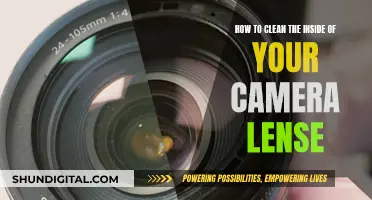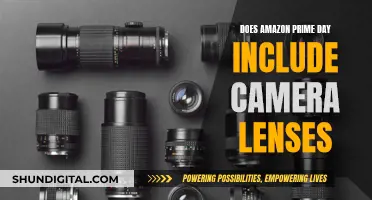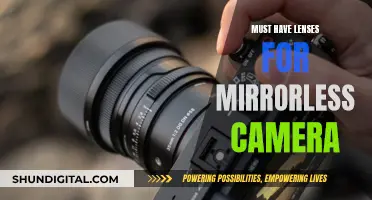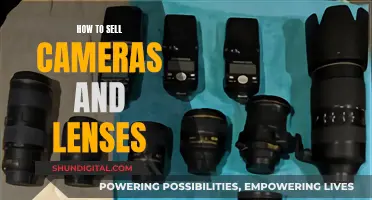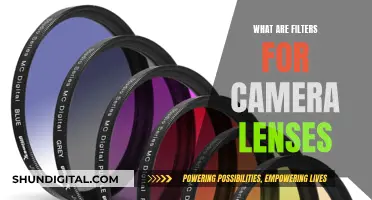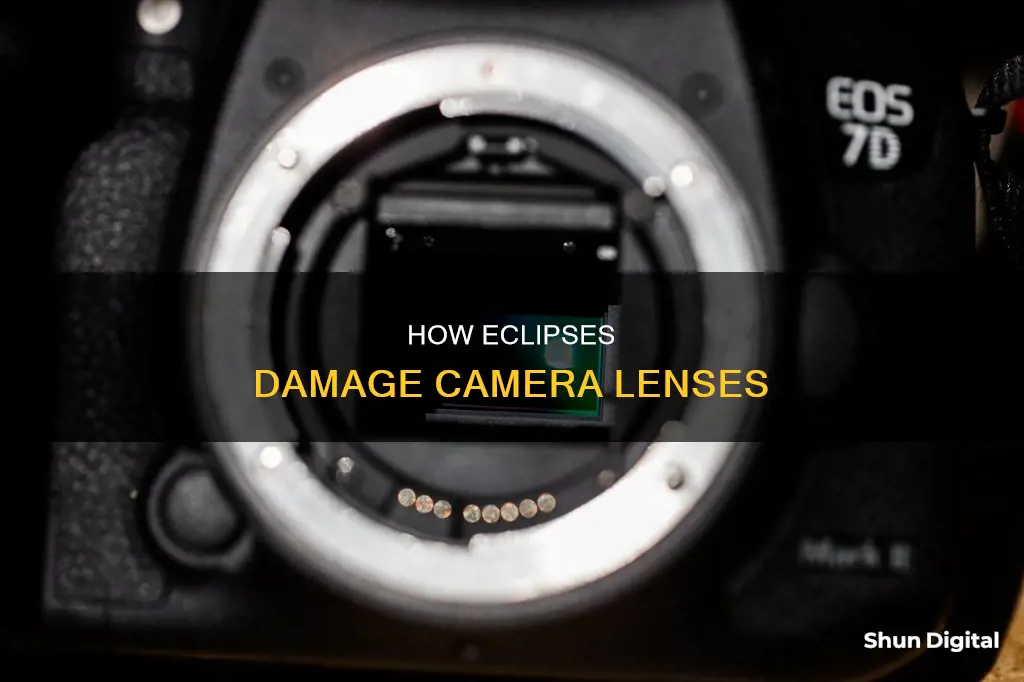
Eclipses can burn camera lenses, but only if the photographer does not take the proper precautions. The sun's rays are extremely powerful and can damage the camera's sensor and lens if the photographer does not use a protective filter. The intense brightness of the sun during an eclipse can cause significant damage to the camera's internal components, including the sensor and aperture blades. This is true for all cameras, from digital cameras to DSLRs and even smartphones. To prevent damage, photographers must use solar filters designed for photography, which block harmful rays while still allowing enough light to enter for an image to be captured.
| Characteristics | Values |
|---|---|
| Risk of damage to camera lens | The intense brightness of the sun during an eclipse can cause significant damage to the camera's sensor and lens if proper precautions are not taken. |
| Damage to internal elements | Leaving the lens pointed directly at the sun for an extended period can damage internal elements (e.g. aperture blades, shutter) due to the lens focusing light on those elements. |
| Sensor damage | The sensor itself can be damaged by prolonged exposure to intense focused light. |
| Overheating | The sun's rays are concentrated and can be magnified by the lens, potentially leading to overheating and damage to the camera's internal components. |
| Eye damage | Accidentally looking directly at the sun through the camera's viewfinder can cause eye damage. |
| Protective equipment | Use a solar filter designed for photography to block out most harmful rays while allowing enough light to capture the eclipse. |
| Protective equipment | Use the camera's live view function or an external monitor to avoid accidentally looking directly at the sun. |
| Protective equipment | Use certified solar filters and follow manufacturer guidelines. |
| Protective equipment | Avoid using homemade filters or sunglasses, as they do not offer sufficient protection and can lead to irreversible eye damage. |
What You'll Learn

Cameras and smartphones are at risk of damage from eclipses
The sun's rays are powerful and can damage your eyes if you look directly at the sun. The same is true for camera lenses and image sensors in smartphones and digital cameras. The intense brightness and heat emitted during a solar eclipse can cause significant damage to the lens and other sensitive components of a camera. Therefore, it is crucial to take the necessary precautions to protect your equipment when photographing an eclipse.
Photography experts warn that pointing your smartphone or digital camera at the sun during an eclipse may cause damage to your device. The risk lies in the concentration of the sun's rays onto the camera's lens, which can cause it to overheat and even burn. This is true for both camera lenses and the sensors in smartphones and digital cameras. The sensors in digital cameras can be damaged by prolonged exposure to intense focused light.
To prevent damage to your equipment, it is essential to use a solar filter designed for photography. These filters are made of special materials that block out most of the sun's harmful rays while still allowing enough light to capture the eclipse. It is important to ensure that the filter is securely attached to the lens, with no gaps or cracks that could allow the sun's rays to enter. Additionally, it is recommended to avoid using the camera's viewfinder during the eclipse and instead use the live view function or an external monitor to avoid accidental eye damage.
Another important precaution is to avoid pointing the camera directly at the sun for extended periods of time, even with a solar filter. Instead, consider using a technique called "eclipse photography," where you capture the surrounding environment and the effects of the eclipse without directly focusing on the sun. This will help reduce the risk of damage to your equipment while still allowing you to capture stunning images of this rare celestial event.
It is also worth noting that advancements in camera technology have made it easier to capture eclipses without causing harm to your equipment. Many modern cameras have built-in safety features that automatically adjust exposure settings to prevent overexposure and potential damage. Additionally, solar filters made for smartphones are relatively inexpensive and easily accessible, providing an extra layer of protection for your device.
Lens Quality: Cost and Performance Factors
You may want to see also

Protective solar filters are necessary
Solar filters are designed to block out most of the sun's harmful rays while still allowing enough light to capture the eclipse. It is important to use certified solar filters that are specifically designed for photography, as other types of filters or sunglasses may not offer sufficient protection. The filter should be securely attached to the lens, with no gaps or cracks that could allow the sun's rays to enter.
Another important precaution is to avoid using the camera's viewfinder to compose the shot. Instead, use the camera's live view function or an external monitor to prevent accidental direct eye exposure to the sun, which can cause irreversible eye damage.
In addition to using a solar filter, it is recommended to avoid pointing the camera directly at the sun for prolonged periods, even with a filter. A technique called ""eclipse photography"" allows photographers to capture the surrounding environment and the effects of the eclipse without directly focusing on the sun, reducing the risk of damage to the camera and eyes.
Furthermore, advancements in camera technology have made it easier to capture eclipses safely. Many modern cameras have built-in safety features that automatically adjust exposure settings to prevent overexposure and potential damage. Staying informed about the latest techniques, equipment, and guidelines from reputable sources is crucial for a safe and successful eclipse photography experience.
Understanding Camera Lenses: Capturing Unique Perspectives
You may want to see also

Prolonged exposure to the sun's rays can cause damage
Photography experts advise against pointing your camera or phone directly at the sun for extended periods of time without a protective solar filter. The sensor on digital cameras and smartphones is always exposed, and the intense brightness of the sun during an eclipse can cause significant damage if proper precautions are not taken. The sensor can be fried, resulting in a dark spot that ruins the camera.
To prevent damage to your camera equipment, it is crucial to use a solar filter specifically designed for photography. These filters are made of special materials that block out most of the sun's harmful rays while still allowing enough light to capture the eclipse. It is important to ensure that the filter is securely attached to the lens, with no gaps or cracks that could allow the sun's rays to enter.
Additionally, it is recommended to avoid using the camera's viewfinder to compose your shots. Instead, use the camera's live view function or an external monitor to avoid accidentally looking directly at the sun, which can cause eye damage. Another option is to use ""eclipse photography," where you capture the surrounding environment and the effects of the eclipse without directly focusing on the sun.
It is worth noting that advancements in camera technology have made it easier to capture eclipses safely. Many modern cameras have built-in safety features that automatically adjust exposure settings to prevent overexposure and potential damage. However, it is still important to follow manufacturer guidelines and use certified solar filters to ensure the safety of your equipment.
How Red Lines on Camera Lenses Affect Your Photos
You may want to see also

The viewfinder should not be used during an eclipse
It is imperative to refrain from using the viewfinder during an eclipse. The eclipse's intense brightness can cause severe damage to the camera's sensor and lens if the necessary precautions are not taken. The sun's rays can be concentrated and focused through the lens, leading to potential damage to the camera's internal components, such as the aperture blades and shutter. This can also cause eye damage.
To avoid these risks, it is strongly recommended to use the camera's live view function or an external monitor to compose your shots. By doing so, you can ensure that you are not accidentally looking directly at the sun. Additionally, it is crucial to use a solar filter designed specifically for photography. These filters are made of materials that block most of the sun's harmful rays while still allowing sufficient light to capture the eclipse. Make sure the filter is securely attached, with no gaps or cracks that could allow the sun's rays to enter.
It is worth noting that modern cameras often have built-in safety features that automatically adjust exposure settings to prevent overexposure and potential damage. However, it is still essential to follow the manufacturer's guidelines and use certified solar filters. The American Astronomical Society (AAS) advises against using unfiltered cameras or smartphones to photograph the sun during an eclipse, as they may not offer sufficient protection.
Furthermore, it is important to be cautious when using any magnifying lens, such as zoom lenses, telescopes, or binoculars. These lenses condense light, increasing the risk of damage to both the camera and your eyes. Always use protective filters in these cases, and never look at the sun through the viewfinder, even with eye protection, without a solar filter over the camera lens.
In summary, to safely capture an eclipse, it is crucial to avoid using the viewfinder and to rely on the camera's live view function or an external monitor. Additionally, always use a certified solar filter to protect your equipment and ensure a safe eclipse photography experience.
GoPro Hero 6: Are Older Lenses Compatible?
You may want to see also

Photographing the surrounding environment is safer
So, what can you do to capture this rare celestial event safely? One option is to use a solar filter. These filters are made of special materials that block out most of the sun's harmful rays while still allowing enough light to enter the lens to capture the eclipse. It is important to ensure that the filter is securely attached and that there are no gaps or cracks that could let the sun's rays through. You can find solar filters for smartphones at major retailers, and they are relatively inexpensive, with some costing less than $10.
Another option is to use a technique called "eclipse photography," where you capture the surrounding environment and the effects of the eclipse without directly focusing on the sun. This can be a safer way to photograph the eclipse, as you avoid the risk of damaging your equipment. You can also try using a lens hood or shade to minimise stray light and improve image quality, and a tripod or other stable support to prevent camera shake.
Additionally, it is important to never look directly at the sun through the camera's viewfinder or LCD screen, as this can cause eye damage. Instead, use the camera's live view function or an external monitor to compose your shots.
Remember, while photographing an eclipse can be exciting, it is crucial to take the necessary precautions to protect your equipment and yourself. Stay informed about the latest techniques and equipment, and always follow safety guidelines from reputable sources.
The Essential Camera Body and Lens Relationship
You may want to see also
Frequently asked questions
Camera lenses can be burned by eclipses due to the intense brightness and heat emitted during the phenomenon. The sun's rays are concentrated and can be magnified by the lens, causing the camera's internal components to overheat and get damaged.
To protect your camera lens during an eclipse, it is recommended to use a solar filter designed for photography. These filters block harmful ultraviolet and infrared rays, reducing the risk of damage to the lens. Ensure the filter is securely attached, with no gaps or cracks. Additionally, avoid using the camera's viewfinder and instead, use the live view function or an external monitor.
Yes, one alternative technique is called "eclipse photography." Instead of directly focusing on the sun, capture the surrounding environment and the effects of the eclipse. This way, you can still enjoy photographing the eclipse without risking damage to your camera equipment.
In addition to using a solar filter, it is important to avoid pointing the camera directly at the sun for prolonged periods. Use a lens hood or shade to minimise stray light and improve image quality. It is also recommended to use a tripod or stable support to prevent camera shake and ensure sharp images. Lastly, always avoid looking directly at the sun through the viewfinder or LCD screen, as it can cause eye damage.


